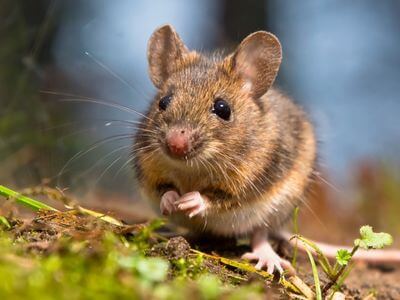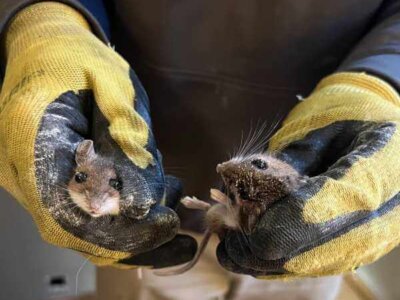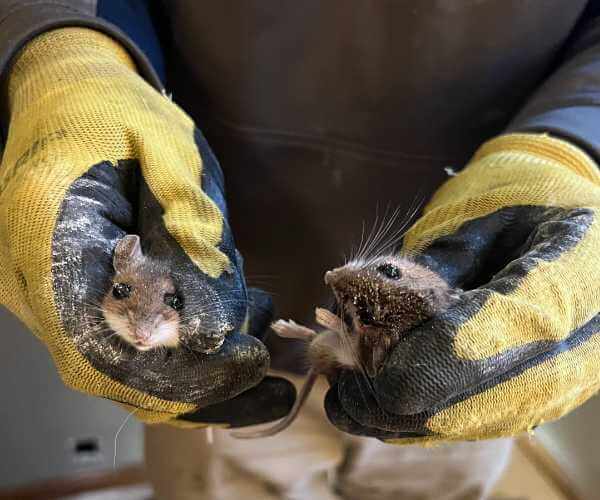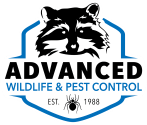
What Does a Mouse Look Like?
Mice are small rodents with large, floppy ears and long, thin, slightly hairy tails. Their noses are triangular in shape, and they have soft fur. Mice are curious creatures exploring new things. They have poor eyesight and rely on their long whiskers to sense their surroundings.
The house mouse is a gray-brown mouse with a nearly hairless tail that is as long as or longer than its body. It is about 5 to 7 inches long, with pointed snouts and large, round ears. House mice are often found in urban areas and frequently invade homes and restaurants in search of food and shelter. They are also known for the high-pitched squeaking noise they make.
The deer mouse, also known as the field mouse, is a reddish-brown mouse with a white underbelly and feet. It is about 2 to 3 inches long with a tail that is approximately half the length of its body. The tail is bicolored, dark on top and light on the bottom, and covered with short, fine hairs. These mice primarily live outdoors in meadows, fields, and wooded areas.
What are the Signs of a Mouse Infestation?
Mice enter homes in search of food, water, and shelter, especially during the fall and winter. These small rodents can squeeze through spaces as tiny as a dime, such as cracks and holes in walls, foundations, vents, and doors. Inside homes, mice are commonly found in the basement, wall voids, crawl spaces, and behind appliances. If you suspect a mouse infestation, here are some signs to watch for:
- Mouse Droppings – Mice leave behind small, pointed droppings about 1/4 inch long along walls, in pantries and cupboards, and under sinks.
- Noises – You might hear scratching or scurrying in your walls or ceilings at night.
- Nesting Materials – Shredded paper, fabrics, insulation, or plant matter.
- Gnaw Marks – Mice gnaw on wood, wires, cardboard, plastic, and metal to obtain food and maintain teeth.
- Tracks or Rub Marks – When mice travel along baseboards or walls, they often leave dark smudge marks of dirt and oil along their path.
- Odor – You may notice strong, musky odors from mouse urine or nest materials.

Professional Mouse Control in Milwaukee, WI
Advanced Wildlife and Pest Control offers mouse removal and exclusion services in Milwaukee, Wisconsin. Mice are prolific and challenging pests to exterminate. Our certified pest specialists effectively trap, remove, sanitize, and exclude mice from your home and business. Rodent exclusion is a crucial step in proper mouse control. Your rodent exterminator will seal openings around your home with heavy-duty closure sealants and materials to prevent future rodent infestations.

How Can I Prevent Mice?
The following prevention tips will help deter mice from your property.
- Store food inside airtight containers or in the refrigerator.
- Regularly wash dishes, vacuum floors, and empty the garbage.
- Clean up crumbs, spills, and food debris.
- Seal up cracks and crevices in the foundation.
- Place weatherstripping around windows and doors.
- Reduce clutter and cardboard in storage areas.
What Problems Do Mice Cause?
Mice are filthy pests that contaminate food, surfaces, and utensils with urine and feces. They can spread harmful diseases such as salmonellosis, leptospirosis, hantavirus, and even plague. Mice can also cause property damage by gnawing on wood and electrical wires. If you own or manage a business like a restaurant, hotel, or retail store, a mouse infestation can severely damage your business’s reputation. If not dealt with promptly, a small mouse problem can quickly escalate into a major infestation due to their rapid reproduction rate.
Mouse FAQs
Frequently Asked Questions
What do mice eat?
Mice are scavengers that will feed on any food available to them. They prefer seeds and nuts in their diet, but this opportunistic feeder will eat almost anything available, including cereal, fruits, pet food, chocolate, and garbage.
Where do mice live?
Dark, protected areas near abundant food sources are ideal habitats for mice. They build nests using materials like shredded paper, cloth, insulation, and grass. In the wild, mice reside in underground burrows or under debris. Cold weather usually drives mice indoors, and common places to find them include walls, ceilings, attics, and crawl spaces.
How many babies do mice have at once?
A female mouse can have six to eight young per litter and a new litter every three weeks. A mouse’s high reproduction rate is one of the reasons why a mouse infestation can quickly grow out of control. The young mice mature quickly and can reproduce within two months.
How long do mice live?
Mice have short lifespans, often living less than a year. They are primary food sources for snakes, hawks, foxes, raccoons, cats, and other animals.
